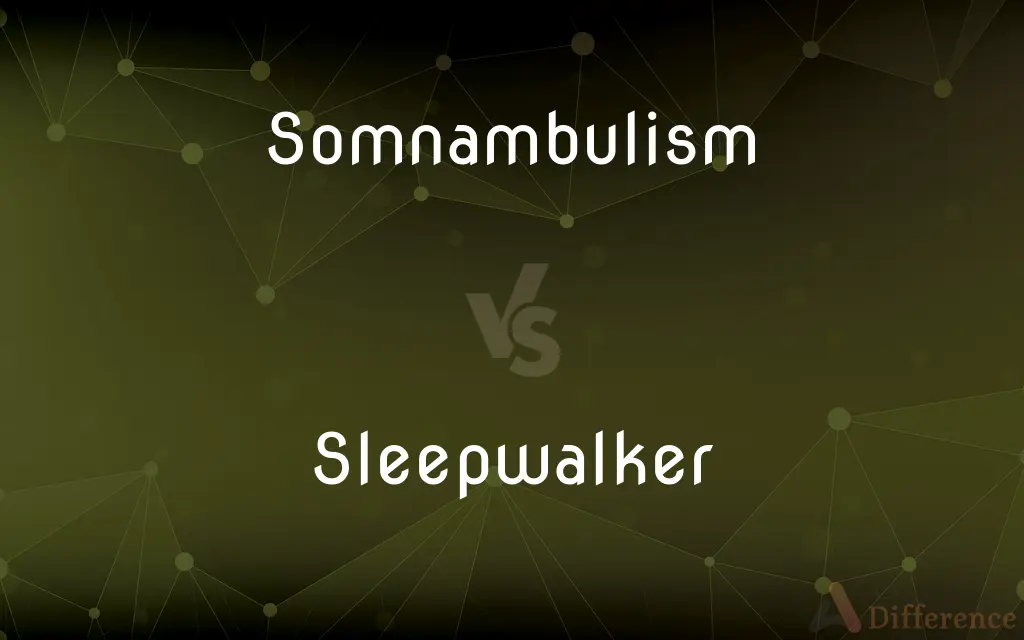Somnambulism vs. Sleepwalker — What's the Difference?
By Tayyaba Rehman & Maham Liaqat — Updated on April 6, 2024
Somnambulism is the medical term for sleepwalking, a condition where a person walks or performs other complex behaviors while asleep. "Sleepwalker" refers to an individual who experiences somnambulism.

Difference Between Somnambulism and Sleepwalker
Table of Contents
ADVERTISEMENT
Key Differences
Somnambulism is a sleep disorder belonging to the parasomnia family, characterized by the occurrence of walking or performing complex tasks while in a state of sleep. It typically occurs during the deep stages of non-REM sleep. Whereas a sleepwalker is someone who experiences these episodes of somnambulism, embodying the condition's manifestations in real-life scenarios.
The study and diagnosis of somnambulism involve understanding the underlying causes, which can range from genetics to stress or sleep deprivation. On the other hand, identifying a sleepwalker usually involves observation of the behavior by others, as the individual is unaware of their actions during the episode.
Somnambulism can manifest in various forms, not just walking; it may include talking, eating, or even driving, indicating the complexity of brain activities during these episodes. Sleepwalkers, consequently, are individuals who might engage in any of these activities, posing potential risks to themselves or others due to the lack of consciousness and control.
Treatment approaches for somnambulism focus on safety measures, managing triggers, and sometimes medication or therapy. For sleepwalkers, personalized strategies are often developed to minimize the risk of injury and address any underlying conditions contributing to the episodes.
Despite somnambulism being a clinical condition, sleepwalkers are not always in immediate need of medical intervention unless the episodes pose significant risks or are symptomatic of deeper issues. The relationship between the two highlights the importance of understanding sleep disorders not just clinically but also in their social and personal dimensions.
ADVERTISEMENT
Comparison Chart
Definition
A sleep disorder characterized by walking or performing other complex behaviors while asleep.
An individual who experiences somnambulism.
Focus
Condition and its mechanisms
The person experiencing the condition
Diagnosis and Observation
Requires professional assessment and diagnosis
Often identified by third-party observations
Manifestations
Can include a wide range of activities beyond walking, such as talking or eating
Specifically refers to the person doing these activities while asleep
Treatment and Management
Focuses on underlying causes, safety measures, and potential medical interventions
Personalized strategies to ensure safety and manage triggers
Compare with Definitions
Somnambulism
A sleep disorder causing people to walk or perform complex tasks while asleep.
Diagnosing somnambulism often involves sleep studies.
Sleepwalker
A person who walks or performs tasks while asleep.
The sleepwalker was found outside, unaware of how she got there.
Somnambulism
Not limited to walking; includes various unconscious activities.
Somnambulism can be a risk when it involves driving.
Sleepwalker
Unaware of their actions during episodes.
As a sleepwalker, he had no memory of eating during the night.
Somnambulism
Treated through environmental safety measures and sometimes medication.
Addressing his somnambulism involved securing the home to prevent exits during episodes.
Sleepwalker
Might require interventions for safety.
They installed alarms to alert if the sleepwalker tried to leave the house.
Somnambulism
Characterized by activities during the deep stages of sleep.
His somnambulism episodes included preparing meals.
Sleepwalker
Can engage in a range of complex behaviors.
The sleepwalker sometimes rearranged furniture.
Somnambulism
Often familial and can be triggered by stress.
Stressful periods tend to increase her somnambulism episodes.
Sleepwalker
Treatment may involve addressing stress or sleep habits.
The sleepwalker reduced caffeine intake, which lessened the episodes.
Somnambulism
See sleepwalking.
Sleepwalker
To walk or perform other motor acts while asleep; somnambulate.
Somnambulism
Sleepwalking
Sleepwalker
Someone who walks about in their sleep.
Somnambulism
A condition of the nervous system in which an individual during sleep performs actions appropriate to the waking state; a state of sleep in which some of the senses and voluntary powers are partially awake; noctambulism.
Sleepwalker
One who walks in his sleep; a somnambulist.
Somnambulism
Walking by a person who is asleep
Sleepwalker
Someone who walks about in their sleep
Common Curiosities
What are common misconceptions about sleepwalkers?
A common misconception is that sleepwalkers act out their dreams, whereas somnambulism occurs during non-REM sleep, not associated with dreaming.
Is sleepwalking dangerous?
Sleepwalking can be dangerous if the individual engages in risky activities; hence, safety measures are crucial.
Can somnambulism be cured?
While there is no cure for somnambulism, many can manage it effectively through safety measures and treatment of underlying causes.
Can children outgrow sleepwalking?
Many children who experience sleepwalking do outgrow it by adolescence.
How prevalent is somnambulism?
Somnambulism affects a small percentage of adults but is more common in children.
Can lifestyle changes reduce sleepwalking?
Yes, improving sleep hygiene, reducing stress, and avoiding alcohol can help reduce episodes.
Are sleepwalkers aware of their environment?
Sleepwalkers are not consciously aware of their environment and will not remember their actions.
Can medication cause somnambulism?
Certain medications can increase the risk of somnambulism in individuals prone to sleepwalking.
Is somnambulism linked to other health issues?
Somnambulism can be associated with sleep disorders like sleep apnea or restless leg syndrome.
What causes somnambulism?
Somnambulism can be caused by genetic factors, stress, sleep deprivation, and certain medications.
How is a sleepwalker diagnosed?
A sleepwalker is often diagnosed based on the observation of their behaviors, followed by medical consultation and sometimes sleep studies.
What should you do if you encounter a sleepwalker?
It's generally recommended to gently guide them back to bed without waking them, to avoid confusion or agitation.
Is it safe to wake a sleepwalker?
Waking a sleepwalker can cause confusion or aggression; it's safer to gently lead them back to bed.
Does somnambulism affect mental health?
Somnambulism can be stressful and impact mental health, highlighting the need for understanding and management.
How can sleepwalkers ensure their safety?
Sleepwalkers can use alarms, lock doors and windows, and clear the sleeping area of hazards.
Share Your Discovery

Previous Comparison
Good vs. Knowledge
Next Comparison
Maleness vs. MasculinityAuthor Spotlight
Written by
Tayyaba RehmanTayyaba Rehman is a distinguished writer, currently serving as a primary contributor to askdifference.com. As a researcher in semantics and etymology, Tayyaba's passion for the complexity of languages and their distinctions has found a perfect home on the platform. Tayyaba delves into the intricacies of language, distinguishing between commonly confused words and phrases, thereby providing clarity for readers worldwide.
Co-written by
Maham Liaqat















































